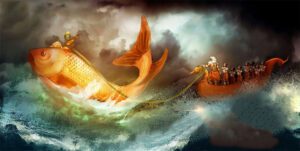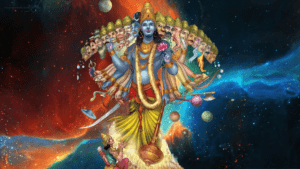The vast ocean of ancient Hindu scriptures has many amazing stories. One such unforgettable story is Lord Vishnu’s Matsya avatar.
![]()
From Fish to Savior: The Story of Lord Vishnu’s Matsya Avatar
Lord Vishnu, the preserver of the universe, holds a special place in Hindu mythology. Known for his numerous avatars, each incarnation serves a distinct purpose to restore cosmic balance and protect dharma. Among these divine transformations is the Matsya Avatar—an intriguing tale that combines elements of creation, destruction, and salvation.
The Matsya Avatar story is not just an ancient fable; it carries profound lessons and insights into humanity’s relationship with nature and the divine. So what exactly led to this mesmerizing transformation? What was at stake during this period? Join us as we explore the story of Lord Vishnu’s Matsya avatar.
Introduction to the Matsya Avatar
According to ancient Hindu texts, before the world we know existed, there was only darkness and chaos. It is said that Lord Vishnu was in a deep sleep on the cosmic ocean, known as the Kshir Sagar. As he slept, a lotus flower bloomed from his navel, and from it emerged Lord Brahma, the creator of the universe.
Brahma then set about creating all living beings and shaping the world with his four heads and four arms. However, his task was not without challenges. He struggled to bring order to the chaotic elements of nature until Lord Vishnu intervened.
Lord Vishnu realized that balance needed to be maintained between creation and destruction for the universe to function smoothly. To achieve this, he took on various avatars throughout time to restore harmony when necessary. One such avatar was Matsya—the fish incarnation of Lord Vishnu.
During the time of the Matsya Avatar, the world was steeped in chaos and moral decay. Humanity had strayed far from righteous paths. Greed, corruption, and ignorance prevailed.
![]()
The sacred texts describe a society plagued by violence and disharmony. The balance of nature had been disrupted as people lost respect for their environment. Rivers ran dry, forests were razed, and animals suffered alongside humans.
Amidst this turmoil, an impending catastrophe loomed—a great flood destined to cleanse the earth of its impurities. At the same time, a demon named Hayagriva stole the sacred texts containing knowledge of creation from Brahma. In fear that this knowledge would be lost forever, Brahma turned to Vishnu for help.
The Birth of Matsya Avatar
In response to Brahma’s plea for help, Lord Vishnu transformed into a small fish known as Matsya and entered the waters of the cosmic ocean. He then grew larger and larger until he was able to swallow up Hayagriva along with the stolen texts.
When all of these incidents were taking place, there was a king turned sage called Manu. King Manu, the progenitor of humanity in Hindu mythology, was a wise and just ruler. His reign marked an era of prosperity and peace. However, his life took a dramatic turn when he received a divine warning about an impending great flood.
One day, while performing rituals by the river, Manu encountered Matsya—a fish with extraordinary intelligence. The fish revealed its true identity as Lord Vishnu. It foretold that soon all living beings would be swept away in a catastrophic flood.
Guided by Matsya’s wisdom, King Manu built a massive ark to save himself and every species on Earth. As the waters rose ominously around him, he gathered seeds and animals—ensuring the continuity of life post-flood.
The Great Flood
As predicted by Matsya, the flood came, and it lasted for years. The cosmic ocean overflowed its boundaries and submerged the entire world. Only Manu’s boat, with all its inhabitants, including animals and plants, stayed afloat on the raging waters.
Matsya appeared in breathtaking glory, guiding Manu’s vessel through tumultuous waves. With each powerful stroke of his tail, he parted the waters and created safe passage amid destruction.

His purpose was clear: protect humanity and ensure that life would flourish once again after devastation. Through this aquatic form, Vishnu became both savior and protector—a beacon of hope amidst despair.
During their time on the boat, Matsya continued to guide Manu and teach him about dharma (duty) and karma (action). He also revealed divine knowledge about creation, life, and death.
The aftermath of the flood and how it impacted humanity
The flood brought about a dramatic transformation in the world. With the waters receding, a fresh landscape emerged. New opportunities for growth awaited humanity.
Manu, saved by Matsya, became the progenitor of mankind. He carried with him seeds of knowledge and wisdom from his divine encounter. This marked the beginning of a new era for human civilization.
![]()
In this rebirth, communities began to form around rivers and fertile lands left behind by the floodwaters. Humanity learned resilience in rebuilding their lives amidst uncertainty.
Moral values flourished as stories of devotion spread through generations. People were reminded that divine forces shaped their fate and existence.
Cultural practices evolved too; rituals celebrating creation took root as gratitude towards Lord Vishnu grew stronger. The Matsya Avatar’s tale echoed through time as a reminder of hope and renewal after disaster struck.
Also Read: 19 Unique Avatars of Shiva
The Rescuer of Knowledge
After many years, when the floods finally receded, Matsya returned to his original form as Lord Vishnu. He then restored Brahma’s stolen texts to him so that he could continue his role as creator of the universe.
Through this act, Matsya not only saved the knowledge of creation but also symbolized the preservation of all living beings and their cultures. He showed that even in times of great destruction, hope and salvation can be found.
The significance of Matsya Avatar
The Matsya Avatar story serves as a reminder of the cyclical nature of life—creation, destruction, and rebirth. It also highlights the importance of balance and harmony in maintaining order in the universe.
Lord Vishnu’s role as the preserver and protector is beautifully portrayed through his incarnation as Matsya. The fish avatar represents resilience, adaptability, and the ability to overcome adversity—a message that still resonates with people today.
Lessons we can learn from the Matsya Avatar’s story
The Matsya Avatar story teaches us about resilience. When faced with overwhelming challenges, perseverance can lead to salvation. Lord Vishnu’s resolve to protect humanity highlights the importance of courage in dire situations.

Furthermore, this story also teaches us about salvation – both physical and spiritual. As Manu builds an ark according to Lord Vishnu’s instructions and saves himself along with other living beings from drowning in the floodwaters, it symbolizes how following one’s dharma (duty) can lead to redemption.
This concept holds true for individuals today as well – by staying true to our moral principles and fulfilling our responsibilities towards society, we can find inner peace and salvation.
Another lesson is humility. Manu and the saptarishi recognized their dependence on divine intervention for survival. This reminds us that seeking help is not a sign of weakness but a step toward wisdom.
Additionally, it emphasizes environmental stewardship. The flood served as a metaphor for destruction caused by neglecting nature’s balance. We are reminded of our responsibility towards preserving the planet.
Lastly, faith plays a crucial role in overcoming adversity. Those who believed in Lord Vishnu’s promise were saved, showcasing how belief can guide us through turbulent times and into safety.
Impact on Hindu Beliefs and Practices
The Matsya Avatar holds a significant place in Hindu beliefs and practices. Devotees often recount the story during religious gatherings, emphasizing its themes of divine intervention and salvation.
In many households, rituals are performed to honor Lord Vishnu as Matsya. These rituals symbolize gratitude for protection against chaos and destruction.
Temples dedicated to Vishnu frequently depict this avatar through sculptures and paintings, reminding worshippers of his nurturing presence in times of crisis.
Festivals like Makar Sankranti celebrate the transition from darkness to light, echoing the lessons learned from the Matsya tale about resilience amid adversity.
Many spiritual leaders reference this story when discussing moral responsibilities towards nature. The message speaks not just to individuals but resonates with communities striving for harmony with their environment.
Modern Interpretations of Matsya Avatar and its Relevance Today
Modern interpretations of the Matsya Avatar resonate deeply in today’s world. As environmental concerns escalate, this ancient tale reminds us of our duty to protect nature. The narrative illustrates the delicate balance between human existence and ecological harmony.
In contemporary discussions about climate change, Matsya serves as a symbol for conservation efforts. Just as Lord Vishnu took on the form of a fish to save life on Earth, many activists advocate for sustainable practices that prioritize planet preservation.
Furthermore, the story encourages adaptability in facing challenges. Today’s complexities often require innovative solutions much like King Manu’s quest for survival amid chaos.
Cultural representations have emerged in literature and art, showcasing Matsya’s relevance across various mediums. These adaptations continue to inspire individuals seeking guidance through turbulent times while fostering a greater appreciation for mythology’s wisdom in modern society.
Conclusion
Ancient Hindu texts are filled with colorful tales that offer valuable insights into life’s mysteries. The story of Matsya Avatar not only teaches us about Lord Vishnu’s role in preserving cosmic balance but also reminds us to have faith and hope even in times of great turmoil. As we dive deeper into our texts, we continue to uncover timeless lessons and messages that are relevant even in modern times.
Also Read: Story of Krishna and Sudama with Pictures.




